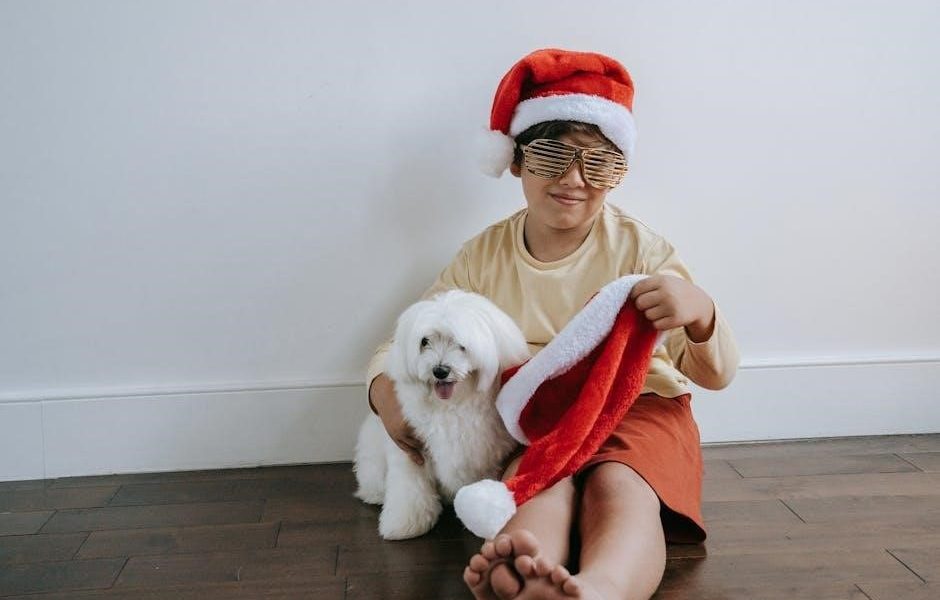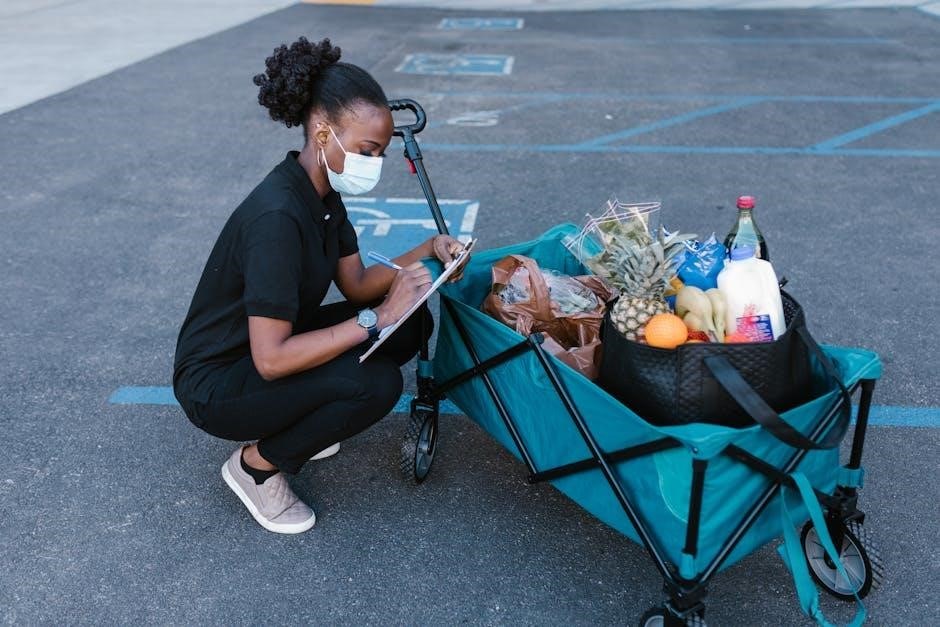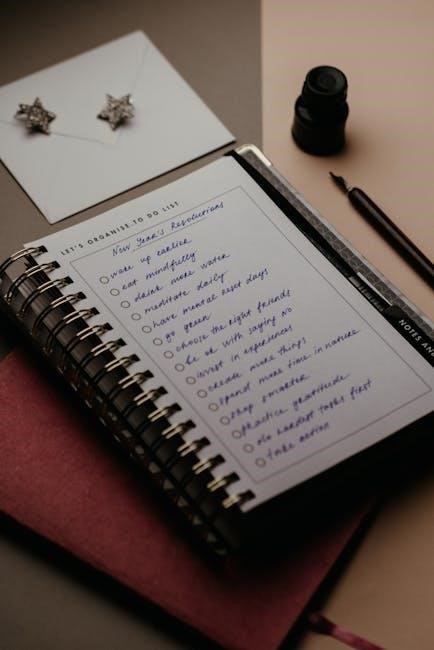
new puppy checklist pdf
Welcome your new furry friend with confidence! This comprehensive new puppy checklist PDF ensures you’re fully prepared, covering essential supplies, home preparation, and health essentials for a smooth transition.
Importance of Preparation for a New Puppy
Preparation is key to ensuring a smooth transition for both you and your new puppy. A well-organized new puppy checklist PDF helps you gather essential supplies, avoiding last-minute stress. It also ensures your home is puppy-proofed and that you’re ready for the responsibilities ahead. Proper preparation creates a safe, welcoming environment, helping your puppy adjust quickly and thrive in their new home.
Overview of the Checklist Categories
This new puppy checklist PDF is divided into key categories to simplify preparation. It includes essential supplies like food bowls, bedding, and toys, as well as home preparation tips for safety and comfort. Additionally, it covers health and wellness, training, and budgeting to ensure a comprehensive approach. Each category is designed to guide you through every step, making the transition smooth and stress-free for both you and your new puppy.

Essential Supplies for Your New Puppy
Gather everything your puppy needs with this new puppy checklist PDF. From food bowls and high-quality puppy food to comfortable bedding, toys, and grooming tools, ensure you’re ready for a happy, healthy start.
Food and Water Bowls
Stainless steel or ceramic bowls are ideal for your puppy, as they are durable and easy to clean. Avoid plastic bowls, as they can harbor bacteria and cause allergies. Ensure the bowls are the right size for your puppy and placed on a non-slip mat to prevent tipping. Keep them clean by washing regularly with mild soap and water to maintain hygiene and prevent illness.
High-Quality Puppy Food
Provide your puppy with nutrient-rich, age-specific food to support growth and health. Choose a vet-recommended brand that aligns with your puppy’s breed, size, and dietary needs. Opt for high-protein, whole ingredient-based formulas, avoiding fillers and by-products. Consider options like grain-free or limited ingredient diets if necessary. Follow the feeding chart on the label and consult your vet for portion control. Monitor your puppy’s growth and adjust their diet as needed for optimal development.
Comfortable Bedding
Ensure your puppy has a cozy place to rest with high-quality bedding. Opt for washable, durable materials like plush dog beds or waterproof mattresses. Consider a crate bed for training or a standalone bed for comfort. Choose the right size to accommodate your puppy’s growth. Orthopedic options can support joint health. Rotate bedding seasonally for comfort and hygiene. A warm, inviting bed helps your puppy sleep soundly, promoting healthy development and a happy temperament. Prioritize ease of cleaning and durability for long-lasting use.
Toys and Chews
Provide a variety of toys and chews to keep your puppy entertained and stimulated. Durable chew toys, interactive puzzle toys, and soft plush toys are essentials. Include long-lasting chews like bully sticks or rubber toys to satisfy chewing instincts. Avoid small parts that could be swallowed. Rotate toys regularly to keep your puppy interested and prevent boredom. Safe, sturdy options ensure your puppy’s playtime is both fun and safe, promoting mental and physical development.
Leash and Collar
A comfortable, adjustable puppy collar and a durable leash are must-haves for walks and training. Choose a collar with a quick-release buckle for safety and adjustability as your puppy grows. Include identification tags with your puppy’s name and your contact information. Opt for a leash made of sturdy materials like nylon or leather, avoiding retractable leashes for better control during training. These essentials ensure safe and enjoyable outings with your new furry friend.
Grooming Tools
Essential grooming tools keep your puppy clean and healthy. A soft-bristle brush or slicker comb helps detangle fur and reduce shedding. Nail clippers are necessary for trimming nails safely. Include a gentle puppy shampoo and conditioner for baths, along with a towel for drying. A dental kit with a toothbrush and puppy-safe toothpaste promotes oral health. These tools ensure your puppy stays well-groomed and comfortable, making grooming a positive experience for both you and your pet.
Crate and Training Pads
A crate is essential for housetraining and providing a safe space for your puppy. Choose a crate that’s spacious enough for your puppy to stand, turn, and lie down comfortably. Add soft bedding like a crate mat for comfort. Training pads are vital for puppies learning to go potty outside. Place them in a designated area indoors to help with accidents. As your puppy grows, you’ll gradually phase out the pads, making the transition to outdoor potty training smoother.
Identification Tags
Ensure your puppy’s safety with proper identification. Obtain an up-to-date microchip and choose a trusted veterinarian. Schedule vaccinations, including rabies and distemper. Administer flea, tick, and heartworm prevention. Conduct parasite testing and consider necessary supplements. These steps ensure your puppy’s health and security, providing peace of mind as they settle into their new home.
Preparing Your Home for the New Puppy
Ensure a smooth transition by puppy-proofing your space, setting up a safe area, and introducing your puppy to family members. This preparation creates a welcoming environment.
Puppy-Proofing Your Space
Thoroughly inspect your home to remove hazards. Secure toxic substances, electrical cords, and fragile items. Block access to dangerous areas like stairs or toxic plants. Use baby gates to restrict movement and ensure safety; This step is crucial for preventing accidents and creating a secure environment for your new puppy to explore and grow safely and happily.
Setting Up a Safe Area for Your Puppy
Designate a quiet, cozy space for your puppy to rest and feel secure. Use a crate or puppy playpen with soft bedding, water, and safe toys. Ensure the area is free from hazards and draft-free. Place familiar items like a blanket with your scent to provide comfort. This safe zone helps your puppy adjust to its new environment, reduces anxiety, and prevents unwanted behavior while you’re away.
Introducing the Puppy to Family Members
Ensure a calm and controlled introduction to family members to prevent overwhelming your puppy. Start with one person at a time, allowing the puppy to adjust gradually. Supervise interactions to ensure safety and positive experiences. Involve all family members to help the puppy become familiar with everyone. This gradual introduction helps build trust and reduces anxiety for both the puppy and the family.

Health and Wellness for Your New Puppy
Ensure your puppy’s health with a vet visit, vaccinations, and preventatives for fleas, ticks, and heartworms. Microchip your puppy for added safety and peace of mind.
Scheduling the First Vet Visit
Schedule your puppy’s first vet visit within the first few days of bringing them home. This initial check-up ensures your puppy is healthy and allows the vet to administer necessary vaccinations. Discuss feeding schedules, parasite testing, and heartworm prevention. Bring any health records from the breeder or shelter. Early vet visits help catch potential issues early, ensuring a strong start for your puppy’s life.
Understanding Puppy Vaccinations
Puppy vaccinations are crucial for protecting your new furry friend from life-threatening diseases. Core vaccines include rabies, distemper, and parvovirus. The vaccination schedule typically starts at 6-8 weeks old, with boosters every 3-4 weeks until 16 weeks. Non-core vaccines may be recommended based on your puppy’s lifestyle and exposure risks. Consult your vet to ensure your puppy receives the right vaccinations at the right time for optimal protection and a healthy start in life.
Flea, Tick, and Heartworm Prevention
Protecting your puppy from fleas, ticks, and heartworms is essential for their health. Topical treatments, oral medications, and preventatives are effective options. Consult your vet to choose the best product for your puppy’s age and health. Consistency is key—monthly applications or prescriptions ensure year-round protection. These preventatives not only safeguard your puppy but also prevent the spread of diseases and discomfort caused by these parasites.
Parasite Testing and Supplements
Regular parasite testing ensures your puppy is free from internal threats like worms. Your vet may recommend fecal exams or blood tests. Additionally, supplements can support your puppy’s growth and immune system. Omega-3 fatty acids, vitamins, and probiotics are common options. Always consult your vet before adding supplements to your puppy’s diet to ensure they receive the right nutrients for optimal health and development.

Training and Socialization
Start early with positive reinforcement techniques and socialization to help your puppy adapt to new environments and people. Include house training and basic commands for a well-behaved companion;
Potty Training Essentials
Potty training is a crucial part of welcoming a new puppy. Essential items include puppy training pads, a consistent feeding schedule, and a designated potty area. Use positive reinforcement like treats and praise to encourage good habits. Monitor your puppy for signs they need to go, and clean accidents thoroughly to prevent confusion. Stick to a routine to help your puppy learn quickly and effectively every day.
Obedience Training Tools
Obedience training tools are vital for teaching your puppy basic commands and good behavior. Essentials include a clicker for positive reinforcement, treat bags for rewards, and a leash and collar for practice. Use high-value treats and consistent commands to encourage learning. A training mat or quiet space can help focus your puppy during sessions. These tools will help you establish a strong bond and set your puppy up for success in obedience training every day.
Socialization Tips for Your Puppy
Socialization is key for your puppy’s confidence and calmness in new environments. Introduce your puppy to various people, animals, and places regularly. Use positive reinforcement with treats and praise during interactions to make experiences enjoyable. Enroll in puppy socialization classes to expose your puppy to other dogs in a controlled setting. Consistent exposure will help your puppy develop good social skills and reduce anxiety in unfamiliar situations, ensuring they grow into a well-adjusted adult dog.

Budgeting for Your New Puppy
Plan wisely to cover initial and recurring expenses for your new puppy. Estimate costs for supplies, vet visits, and emergencies to ensure financial readiness and avoid stress.
Initial Costs for Supplies
The initial costs for your new puppy include essential items like food bowls, a high-quality crate, comfortable bedding, and durable toys; Additionally, you’ll need a leash, collar, and grooming tools. These one-time expenses ensure your puppy has everything needed for a comfortable and safe start. Budgeting for these items upfront helps create a stress-free environment for both you and your new furry friend.
Recurring Expenses
Recurring expenses for your new puppy include high-quality puppy food, monthly vet visits, and flea, tick, and heartworm prevention. Additionally, toys and chews will need regular replacement. Budgeting for these ongoing costs ensures your puppy remains healthy and happy. Planning for these expenses helps you provide consistent care and avoid financial surprises along the way.
Emergency Fund for Vet Visits
Creating an emergency fund for vet visits is crucial to ensure your puppy receives timely care. Unexpected expenses, such as accidents or illnesses, can arise. Allocate a portion of your budget for emergencies, ensuring you’re prepared for any situation. This fund will help cover unplanned vet bills, providing peace of mind and financial security for your puppy’s health.
Leave a Reply
You must be logged in to post a comment.